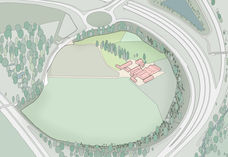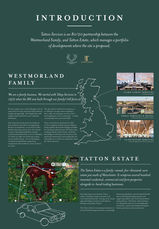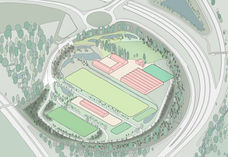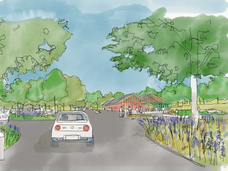THE
TATTON SERVICES
PROPOSAL

PLANNING APPLICATION
Planning Update: December 2025
Following the granting of planning permission in March 2025, we have been advancing the detailed design of the scheme in collaboration with our team of consultants and appointed contractors.
As is typical with projects of this scale and complexity, a number of minor design refinements have emerged during the detailed design phase. To address these, a S73 Planning Application (commonly referred to as a Minor Material Amendment application) was submitted to Cheshire East Council in September 2025, with a decision expected in January 2026.
The proposed amendments include a reduction in the roof height of the main amenity building, the introduction of a phased development plan, and adjustments to the internal road layout to enhance customer safety and accessibility. Additionally, the application provides details of the pre-commencement planning conditions requiring approval prior to the start of construction. Commencement of the development is anticipated in Spring 2026, with a target opening of late 2027 / early 2028.
Planning Update: March 2025
The scheme was initially approved by Cheshire East Council in October 2023, however the application was called in for determination by the Secretary of State in May 2024.
Following this review, we are pleased to confirm that planning permission was granted in March 2025. The Secretary of State agreed with the Inspector’s recommendation to approve the application, recognising the significant safety, welfare, economic, and environmental benefits of the development.
The approved scheme includes:
-
A new Amenity Building, MSA Hotel, Fuel Filling Station, Service Yards, and parking for all vehicles including EV charging.
-
Demolition of some redundant buildings, whilst retaining the farmhouse and barns for mixed operational use.
-
Landscaping, open spaces, pedestrian and cycle links, and supporting infrastructure.
The Secretary of State concluded that the benefits of the development outweigh any potential environmental, heritage, or visual impacts. Work can now progress in line with the approved plans and conditions.
The Proposal
The Tatton Services partnership is a joint venture between Westmorland Family, known for its facilities at Tebay Services on the M6, Gloucester Services on the M5 and Cairn Lodge Services on the M74, and the Tatton Group, built on Tatton Estate land.
Tatton Services vision is to build on the distinctive model that Westmorland operates, which champions local food, craft and community to create a sustainable business which embraces the future of motorway travel. As the project is in the Green Belt, the next stage is for local planning authority to consult the Secretary of State on their proposed decision.
Tatton Services offerings include a fuel refilling station, a farmshop and kitchen (amenity building), a 100-bed hotel, all with energy efficiency and generation technologies, as well as 96 EV charging spaces, further enhancing the services available to travellers. Importantly, this project will generate 325 new jobs, with a commitment to local employment, training and working with local businesses to source produce for sale on site.
A summary of each of the submitted documents is provided here:
Drawings
A full set of drawings has been submitted showing the existing site and buildings; the proposed layout of the MSA buildings and outdoors spaces; and building details including elevations, roofs and indicative materials. The Masterplan illustrates the overall approach to site design, whilst the Parameters Plan sets the development parameters which formed the basis for the Environmental Impact Assessment. In addition, details are provided that show access, site levels and drainage proposals.

Planning Statement
The Planning Statement provides an assessment of the proposal against planning context and policies (local and national) and other material considerations relevant to the determination of the application. It concludes that 'Very Special Circumstances' have been demonstrated to justify development in this Green Belt location taking consideration many environmental, economic and social benefits the scheme will deliver.

Design and Access Statement
The Design and Access Statement (DAS) explains the design evolution, including the principles and concepts that have been applied to the Proposed Development, as well as how comments, opportunities and challenges relating to access, environment and sustainability have been taken on board.
For Tatton Services, a holistic design approach was taken, which sought to take into account the history and character of the site and surroundings, the environment in which it sits and with sustainability at the heart of each building.
There was iterative, technical, environmental and stakeholder feedback, which led to significant design changes, resulting in an even better overall scheme being submitted.
The DAS concludes by presenting the final design proposal, which consists of three key buildings: the Amenity Building, MSA Hotel and Fuel Barn situated around well-designed outdoor spaces including a kitchen garden and parking fields, all of which consistent with the ‘farmyard’ narrative of the past, sitting within the well screened but beautiful landscape. Further detail of the buildings, including their architecture, built form and proposed materials, of which there are three including rammed earth, are presented.

MSA Gap Analysis
Safety – the MSA Gap Analysis
This report summarises the guidance relating to spacing of MSA and applies it to the Strategic Road Network in the location of Tatton Services. It identifies that there are 20 gaps in MSA provision when considering each direction. There are a further 8 gaps in MSA provision for HGVs due to Knutsford only providing emergency HGV parking.
There is a demonstrable need for a MSA so that drivers are able to stop and take a break on their journey. Tatton Services would remove 9 of the 20 gaps to be within 28 miles and would reduce the distance and journey times on the remaining gaps. Of the remaining 11 gaps, 4 of these become consolidated (i.e. have the same start and end point) and therefore 7 gaps would remain.
The further 8 gaps in MSA provision for HGVs would be removed to 4, with 4 remaining. These remaining 4, however, are consistent with the 7 remaining MSA gaps identified.
In conclusion, there is a need for a MSA in this location. A new MSA at Tatton Services would close 13 gaps (9 MSA and 4 HGV) and consolidate/ reduce the number of gaps to 7. These remaining gaps would be much shorter than the present gaps, some of which are marginally above the 28 mile threshold.
Alternatives Sites Assessment
This report considers potential alternative sites to accommodate a Motorway Service Area. It seeks to identify if there are any alternative locations that could better meet the need for a MSA to address the MSA gaps identified in the Gap Analysis Report when compared to the Application Site, as well as taking into consideration environmental factors; and demonstrates there are no suitable and available sites outside the Green Belt that can meet the need identified.
It considers potential other sites at online (not at a junction) and offline (junction sites) locations. The report shortlists 6 sites for consideration, including the application site. It is concluded that the Application Site is the most suitable site for a MSA, both in terms of closing more gaps and having fewer environmental impacts.
Environment Statement: Environmental Impact Assessment
The Environment Impact Statement which is reported in the Environment Statement has studied in detail the likely significant effects on the environment of the construction and operational stages of the Proposed Development.
Key headlines in relation to each of the topic areas are set out below:
-
Socio economic issues: Overall the Proposed Development will provide significant positive effects: including 234 jobs, £9.2m gross value added per annum in the regional economy; generating an estimated £628,000 per annum in business rates; paying onsite staff £4.7m in combined annual wages.
-
Landscape and visual: With mitigation the total extent of the landscape and visual effects would be localised and limited in nature. It would not be detrimental given the existing context of surrounding road infrastructure and would benefit from high quality design and mitigation, which integrates the scheme. The only long-term significant effect is restricted to the inevitable direct physical effects on the land use of the Site.
-
Ecology: A range of surveys have been carried out. The proposals were developed iteratively in response to environmental constraints and mitigation and enhancement 'by design' has been embedded to protect and enhance existing features, habitats and species, which has resulted in no adverse significant effects. The landscape strategy provides a significant Biodiversity Net Gain of at least 20% and 10% habitat and hedgerow units respectively, which will deliver benefits. It is considered that there will be no adverse effects on Rostherne Mere (a Ramsar, SSSI and NNR).
-
Heritage: It is important to note that there is no visibility between Tatton Services from Dunham Massey hall or parkland. It is not within the setting of Dunham Massey and has never been part of the Dunham Massey estate. The operation of the Proposed Development will cause no change to Dunham Massey. Overall, there are a limited range of effects on a small number of heritage assets. Importantly, the Proposed Development provides the opportunity to restore Yarwood Heath Farmhouse and bring back into optimal viable use.
-
Agriculture and soils: There will be permanent loss of 13.0 hectares of Grade 2 agricultural land, which is below the threshold for consultation with Natural England. The land is detached from other farmland by the road network. There will be localised effects on agricultural occupiers of the land. These adverse effects are not significant and are inevitable when land or buildings are taken out of agricultural use.
-
Ground Conditions: No significant contamination was found following survey work. It has been identified that mitigation to manage construction impacts will ensure no residual impacts would remain.
-
Water Resources: The Application Site is within Flood Zone 1 and is predominantly at very low risk of flooding from surface water sources. Rostherne Mere Ramsar SSSI and NNR, is located to the south of the Application Site, but not considered to be connected to the site from a fluvial, ground water or foul water management perspective. Surface water is proposed to be managed sustainably through the use of SuDS and above ground storage to also provide treatment, which will improve water quality.
-
Transport and Access: The nature of the Proposed Development would create very few additional journeys. It would likely make some change to the pattern of traffic movements on the transport infrastructure surrounding the Site. The impacts of this have been assessed and a number of highway improvements were identified to be required. This includes changes to the layout of Bowdon North and South roundabouts to increase capacity and segregate traffic. In addition, it is proposed that the existing Cycle Track will be realigned as part of the proposal. The proposed mitigation and enhancement measures will ensure that there will be no adverse significant effects in relation to transport and access matters. Furthermore, the role of the MSA in meeting safety and welfare needs is significant benefit.
-
Noise and Vibration: Baseline surveys were undertaken, which established the existing noise climate is dominated by the road traffic on surrounding infrastructure. Mitigation measures will ensure no residual effects from noise and vibration are anticipated.
-
Air Quality: The Site is not located within an Air Quality Management Area and local air quality identified that pollutant concentrations were well below the relevant air quality objectives. Mitigation is proposed to ensure construction impacts are minimised, but otherwise operationally no mitigation measures were needed.
In conclusion, environmental effects have been fully taken into account. Where necessary, mitigation measures have form an integral part of the scheme and ensure that the environment is suitably protected and any adverse impacts are minimised.
Consultation Statement
This report explains the consultation and engagement undertaken whilst preparing the planning application, identifies feedback and specifically show how this feedback has been incorporated in the proposal.
In summary, the public consultation for Tatton Services took a variety of forms, including early and continued communication with key stakeholders and distribution of awareness raising leaflets delivered to some 14,800 properties in the local area. A project website was launched from the outset, with updated information during the consultation period. Two public exhibitions were held, as well as virtual webinar, in addition to a number of stakeholder briefings. A total of 466 responses were received from the public and, of these, 55% were positive, 15% neutral and 29% negative. (1% short due to rounding)
In response to the consultation with stakeholders and public, the proposal has evolved to: change the access arrangements; expanded the viewpoints from which the Proposed Development was assessed from which lead to additional landscaping and mitigation; further testing of the massing of buildings; enhancements to improve the segregation of traffic on the South Bowdon roundabout and; discussions are ongoing in relation to a number of other wider initiatives, such as delivering wider cycling connections, that are not directly related to this proposal.
Overall, the consultation and engagement has been a positive, inclusive, meaningful and beneficial process, which has shaped both the design and associated benefits to be delivered as part of the application. We would like to thank the many people who have given their time to help with this even during the challenges of Covid-19.

The Social and Economic Benefits of Tatton Services
It has been identified that Tatton Services will make a significant long term economic contribution to the whole of the region. The main social and economic benefits include:
-
558 temporary jobs per annum supported by the construction phase;
-
Generation of an additional £66.4million of gross value added to the regional economy during the construction phase;
-
223 gross permanent full time equivalent jobs on site during operation;
-
234 net full time equivalent jobs on site and in the wider regional economy;
-
£9.2million per annum contribution to economic output;
-
£4.7million per annum generated in estimated wages for on-site staff;
-
Commitments to employing local residents;
-
Provision of relevant training to allow employees to progress in their careers through a clear development pathway;
-
Anticipated that Tatton Services is likely to support 130 local suppliers and 70 regional suppliers;
-
Contribution to a minimum of £100,000 per annum to local charities and community causes.
Please see the Sustainability page for a summary of the:
Sustainability Statement
Energy Strategy; and
Electric Vehicle Charging Strategy
Utilities Report
This report identifies existing utility infrastructure and identifies a strategy for delivering the utility supplies to the site in relation to electricity; telephony and broadband; gas; water and drainage.
S106 Legal Agreement – Draft Heads of Terms
This outlines proposed commitments, identified and justified in other planning application documentation, that the Applicants will enter into a Legal Agreements upon, which includes topics such as: Sustainable Transport; Local Employment and Apprenticeships; Local Procurement; Biodiversity; EV Charging; Energy; Tourist Information and works to Yarwood Heath Farmhouse.
The planning application documentation is available via the Cheshire East Council's website. The planning application reference number is 22/0872M. The Council's consultation period for comments is set out as a key date on their website.
For project enquiries contact: tattonservices@pegasusgroup.co.uk





















